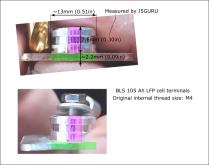The terminals consist of an aluminum block which is ultrasonically welded to the current collectors (aluminum or copper) foil inside the cells. If you go deep enough on the anode you should see copper from the weld area. On the cathode its aluminum all the way through.
From the video above it should be similar on the larger cells.
View attachment 36901
Some cells use a different fastening method for the current collector foils, but these high density aluminum cased prismatics have limited space.
I have not had an LFP cell apart, but reports are that the electrolyte has a strong chemical odor. Its a clear-ish liquid with low viscosity. If you penetrated the cell, you should be able to invert it and see/smell the liquid.
I have not seen any prismatics with separate pouches. While there are various layouts for the sandwich (rolls, flip flop, etc), they all share a common electrolyte.




